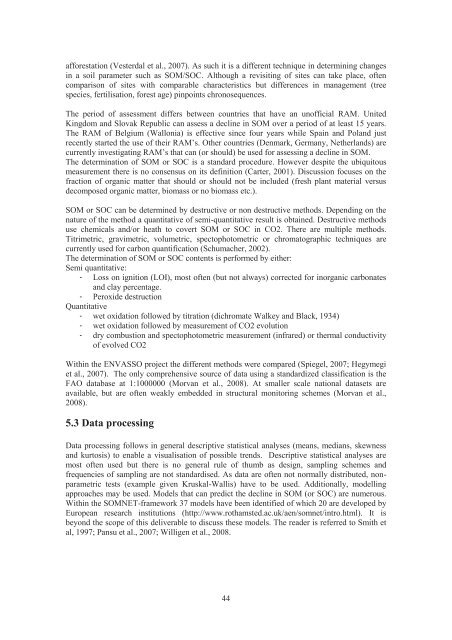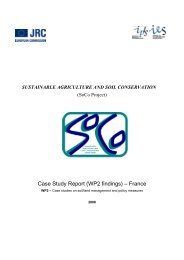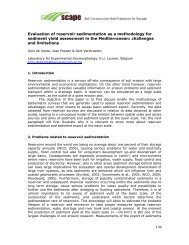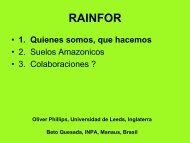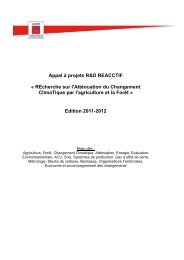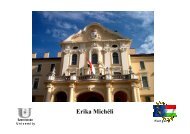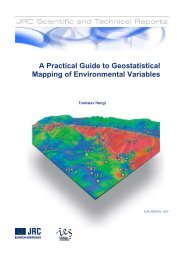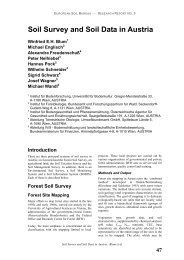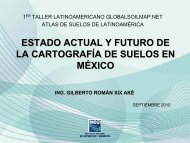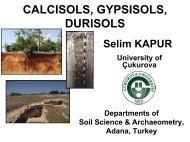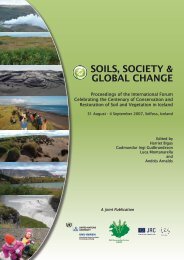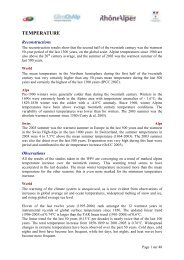Risk Assessment Methodologies of Soil Threats in Europe
Risk Assessment Methodologies of Soil Threats in Europe
Risk Assessment Methodologies of Soil Threats in Europe
You also want an ePaper? Increase the reach of your titles
YUMPU automatically turns print PDFs into web optimized ePapers that Google loves.
afforestation (Vesterdal et al., 2007). As such it is a different technique <strong>in</strong> determ<strong>in</strong><strong>in</strong>g changes<br />
<strong>in</strong> a soil parameter such as SOM/SOC. Although a revisit<strong>in</strong>g <strong>of</strong> sites can take place, <strong>of</strong>ten<br />
comparison <strong>of</strong> sites with comparable characteristics but differences <strong>in</strong> management (tree<br />
species, fertilisation, forest age) p<strong>in</strong>po<strong>in</strong>ts chronosequences.<br />
The period <strong>of</strong> assessment differs between countries that have an un<strong>of</strong>ficial RAM. United<br />
K<strong>in</strong>gdom and Slovak Republic can assess a decl<strong>in</strong>e <strong>in</strong> SOM over a period <strong>of</strong> at least 15 years.<br />
The RAM <strong>of</strong> Belgium (Wallonia) is effective s<strong>in</strong>ce four years while Spa<strong>in</strong> and Poland just<br />
recently started the use <strong>of</strong> their RAM’s. Other countries (Denmark, Germany, Netherlands) are<br />
currently <strong>in</strong>vestigat<strong>in</strong>g RAM’s that can (or should) be used for assess<strong>in</strong>g a decl<strong>in</strong>e <strong>in</strong> SOM.<br />
The determ<strong>in</strong>ation <strong>of</strong> SOM or SOC is a standard procedure. However despite the ubiquitous<br />
measurement there is no consensus on its def<strong>in</strong>ition (Carter, 2001). Discussion focuses on the<br />
fraction <strong>of</strong> organic matter that should or should not be <strong>in</strong>cluded (fresh plant material versus<br />
decomposed organic matter, biomass or no biomass etc.).<br />
SOM or SOC can be determ<strong>in</strong>ed by destructive or non destructive methods. Depend<strong>in</strong>g on the<br />
nature <strong>of</strong> the method a quantitative <strong>of</strong> semi-quantitative result is obta<strong>in</strong>ed. Destructive methods<br />
use chemicals and/or heath to covert SOM or SOC <strong>in</strong> CO2. There are multiple methods.<br />
Titrimetric, gravimetric, volumetric, spectophotometric or chromatographic techniques are<br />
currently used for carbon quantification (Schumacher, 2002).<br />
The determ<strong>in</strong>ation <strong>of</strong> SOM or SOC contents is performed by either:<br />
Semi quantitative:<br />
- Loss on ignition (LOI), most <strong>of</strong>ten (but not always) corrected for <strong>in</strong>organic carbonates<br />
and clay percentage.<br />
- Peroxide destruction<br />
Quantitative<br />
- wet oxidation followed by titration (dichromate Walkey and Black, 1934)<br />
- wet oxidation followed by measurement <strong>of</strong> CO2 evolution<br />
- dry combustion and spectophotometric measurement (<strong>in</strong>frared) or thermal conductivity<br />
<strong>of</strong> evolved CO2<br />
With<strong>in</strong> the ENVASSO project the different methods were compared (Spiegel, 2007; Hegymegi<br />
et al., 2007). The only comprehensive source <strong>of</strong> data us<strong>in</strong>g a standardized classification is the<br />
FAO database at 1:1000000 (Morvan et al., 2008). At smaller scale national datasets are<br />
available, but are <strong>of</strong>ten weakly embedded <strong>in</strong> structural monitor<strong>in</strong>g schemes (Morvan et al.,<br />
2008).<br />
5.3 Data process<strong>in</strong>g<br />
Data process<strong>in</strong>g follows <strong>in</strong> general descriptive statistical analyses (means, medians, skewness<br />
and kurtosis) to enable a visualisation <strong>of</strong> possible trends. Descriptive statistical analyses are<br />
most <strong>of</strong>ten used but there is no general rule <strong>of</strong> thumb as design, sampl<strong>in</strong>g schemes and<br />
frequencies <strong>of</strong> sampl<strong>in</strong>g are not standardised. As data are <strong>of</strong>ten not normally distributed, nonparametric<br />
tests (example given Kruskal-Wallis) have to be used. Additionally, modell<strong>in</strong>g<br />
approaches may be used. Models that can predict the decl<strong>in</strong>e <strong>in</strong> SOM (or SOC) are numerous.<br />
With<strong>in</strong> the SOMNET-framework 37 models have been identified <strong>of</strong> which 20 are developed by<br />
<strong>Europe</strong>an research <strong>in</strong>stitutions (http://www.rothamsted.ac.uk/aen/somnet/<strong>in</strong>tro.html). It is<br />
beyond the scope <strong>of</strong> this deliverable to discuss these models. The reader is referred to Smith et<br />
al, 1997; Pansu et al., 2007; Willigen et al., 2008.<br />
44


